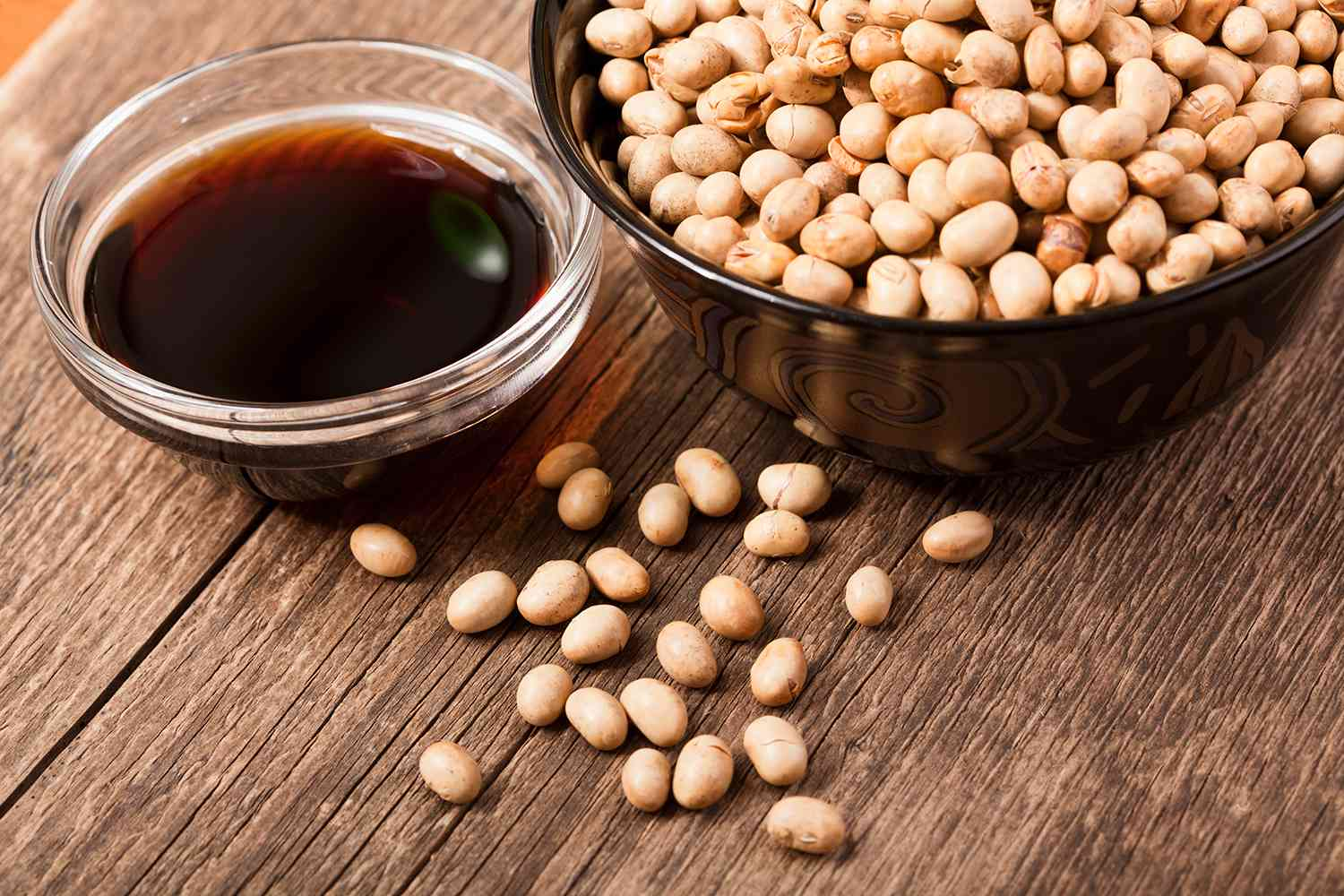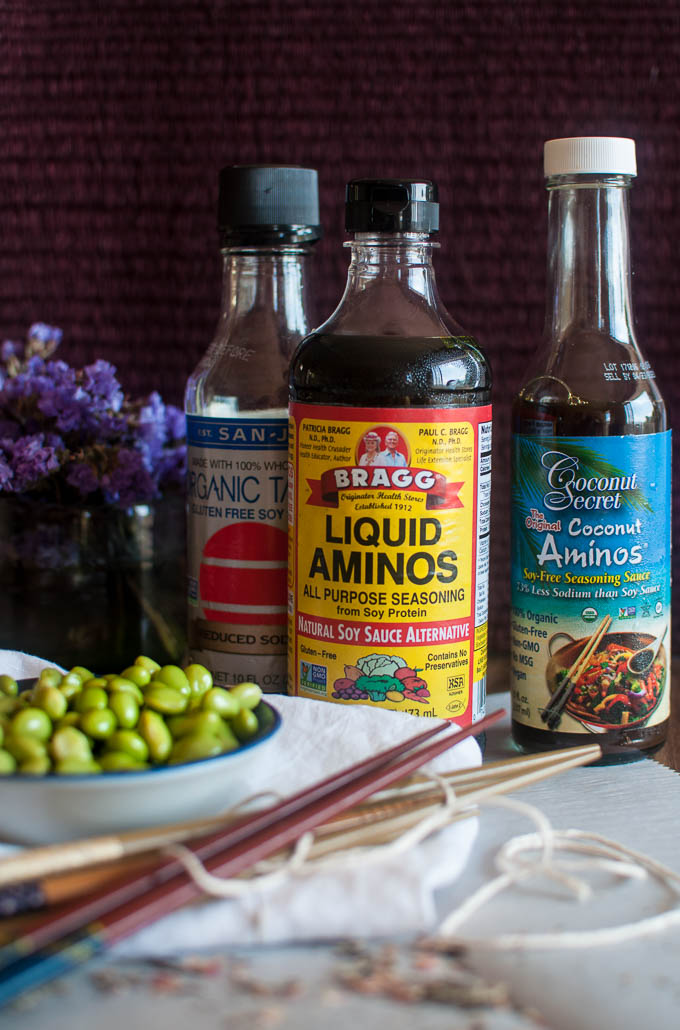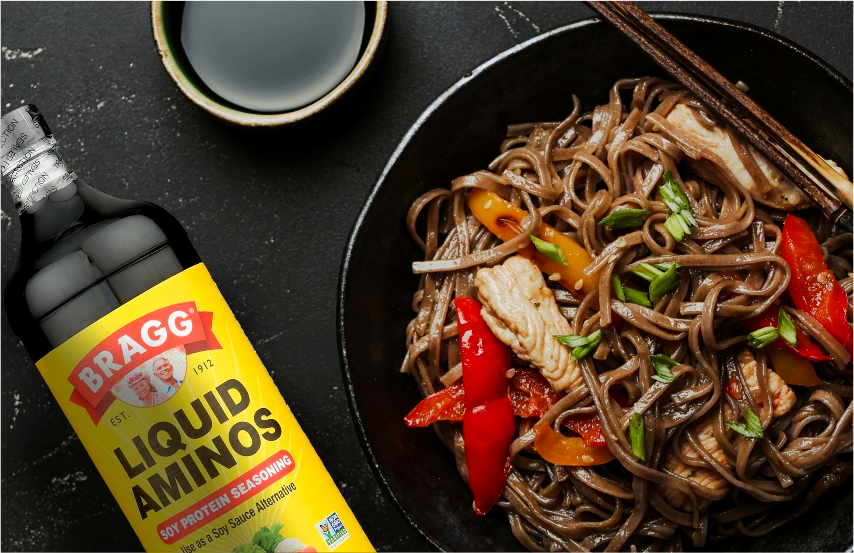Vegan Globetrotter is supported by our audience. When you purchase through one of our links, we may earn a small affiliate commission. As an Amazon Associate I earn from qualifying purchases. Your cost is not affected.
==================
Hey there, food enthusiasts! Have you ever wondered about the buzz surrounding liquid aminos as a soy sauce alternative? Well, you’re in for a treat because we’re about to dive into the world of Liquid Aminos. Join us as we unravel everything you need to know about Liquid Aminos – your new secret ingredient for healthier and tastier meals.
Unlocking the Mystery: Liquid Aminos Demystified

Photo by: OneGreenPlanet
Liquid aminos are a natural soy sauce alternative that’s been gaining popularity lately. One of the cool things about liquid aminos is its versatility. You can use it in cooking just like soy sauce – in marinades, stir-fries, dressings, you name it. So, if you want to add a punch of flavor to your dishes while keeping things healthier, liquid aminos might be your new kitchen staple.
Key Takeaways
- Versatile Flavor Booster: Liquid aminos offer a healthier, gluten-free alternative to soy sauce for enhancing dishes.
- Nutrient-Rich Option: Packed with essential amino acids, liquid aminos cater to various dietary preferences.
- Mindful Moderation: Be cautious of potential downsides like higher cost, sodium content, and allergic reactions, emphasizing moderation in usage.

What Exactly Are Liquid Aminos?

Photo by: Allrecipes
Let’s dive into the world of liquid aminos, where flavor meets versatility! This term covers any liquid seasoning crafted from concentrated amino acids, the essential building blocks of protein. Now, there are two main ways these liquid wonders come to life:
From Soybeans

Photo by: The Spruce Eats
Imagine soybeans taking a luxurious soak in an acidic solution. The result? The protein transforms into individual amino acids. These heroes are filtered, concentrated, and sometimes joined by a bit of water and salt, creating liquid aminos. Bragg Liquid Aminos and Eden Organic Liquid Aminos have your back.
From Coconut Sap

Photo by: Daily Mail
Now, here’s the tropical twist! Coconut sap gets cozy with salt and water in a slow fermentation dance. This traditional method turns the sap’s sugars into amino acids, offering a unique, slightly sweet flavor. If coconuts are your vibe, check out Coconut Liquid Aminos and Bragg Coconut Aminos.
What’s cool is that liquid aminos from coconut bring more to the table than just flavor. They contain essential amino acids and are often gluten-free, adding an extra layer of goodness to your meals.
So, whether you’re whipping up a gluten-free delight or simply elevating your dish with amino sauce, liquid aminos are the culinary secret you’ve been looking for!
Unlocking the Goodness: Key Features of Liquid Aminos

Photo by: The Passionate Vegan
Let’s chat about the awesome things that make Liquid aminos awesome:
- Taste: Picture this – a savory, umami explosion that rivals traditional soy sauce. But here’s the twist: it’s often a bit milder and sneakily sweeter, creating an umami flavor sensation.
- Nutrition: While it won’t make you a bodybuilder overnight, it’s a rockstar source of amino acids. And guess what? It’s naturally gluten-free and vegan-friendly, making it a fantastic alternative to soy sauce.
- Uses: This liquid dynamo isn’t shy about showing off its skills. Use it as a soy sauce sidekick in almost any dish, or sprinkle it to elevate the flavor. From marinades and salad dressings to stir-fries and soups, it’s your all-access pass to deliciousness.

So, whether crafting an amino sauce masterpiece or seeking an alternative to traditional soy sauce, liquid aminos are your flavor revolution in a bottle!
Unveiling the Wellness Wonders: Benefits of Liquid Aminos

Photo by: Lindos Group of Companies
Let’s talk about the goodness packed into liquid aminos! This kitchen superstar isn’t just about flavor; it’s got some potential benefits perk. Here’s the lowdown on a few of them:
Packed With Amino Acids
So, liquid aminos contain both essential and non-essential amino acids, which are basically the Lego bricks of protein in your body. But here’s the thing: when you cook, you usually only use a little bit of them, so they’re not exactly your main protein source.
Gluten Free Diet
These goodies are totally gluten-free and vegan, so they’re perfect for people with those dietary preferences or restrictions.
Speaking of coconut aminos, they’ve become a rockstar, especially for our paleo pals. Why? They skip legumes like soybeans and opt for the magic of fermented sap. It’s like a taste revolution that caters to different dietary needs, making it a particularly popular choice among those following the paleo diet.

Free From Chemical Preservatives
Sodium benzoate is like the superhero of preservation—it’s added to foods, including commercially prepared soy sauces, to give them a longer shelf life and keep those pesky bacteria and fungi at bay. Now, in small amounts, it’s generally considered safe, but here’s the plot twist: some folks might be allergic to it. Cue hives, itching, swelling, or a runny nose for some unlucky ones.
Now, let’s talk liquid aminos—the chemical-preservative-free champs! They’re not just a tasty amino sauce alternative but the go-to choice for those steering clear of benzoates.
A Gentler Flavor Compared to Soy Sauce
Let’s talk liquid aminos – they’re like the milder, more easygoing cousin of soy sauce. Soy-based liquid aminos take it down a notch, offering a gentler and slightly sweeter flavor.
Here’s the salty scoop – soy sauce and soy-based liquid aminos pack a sodium punch, around 300 mg per teaspoon (5 ml). But wait, coconut aminos swoop in with a game-changer, boasting about 60% less sodium. How? Well, soy-based liquid aminos get their sodium during processing, while coconut-based ones add a sprinkle of sea salt.
Here’s the fun part – the color, texture, and flavor of liquid aminos and soy sauce are like culinary twins, making them the ultimate kitchen buddies. You can swap them out in most recipes without missing a beat.
Reduce Feelings of Hunger
Let’s dive into the world of umami – it’s like the cool five major taste sensations squad, hanging out with salty, sweet, sour, and bitter.
So, umami’s game is all about that savory, meaty flavor, and it kicks in when free glutamate is present. Free glutamate happens when glutamic acid, a natural amino acid in protein, breaks down.
Guess what? Liquid aminos bring the umami party to your taste buds. Thanks to the breakdown of proteins in soybeans or coconut sap, they’re loaded with natural glutamate, sparking that delightful umami flavor and making your food way more enjoyable (source 16).
Here’s the cool part: research shows that slurping umami-flavored broths and soups before meals can tone down hunger and put the brakes on snack attacks. Liquid aminos can be easily added to your diet.
Exploring the Differences Between Amino Acids and Soy Sauce

Photo by: Weight Loss Direct
When it comes to liquid aminos versus soy sauce, they’re both great for adding that savory umami kick to your dishes. But there are some pretty important differences you might want to know about:
Ingredients and Processing
- Liquid Aminos: It’s soybeans and water. They break down the soybeans with either acid or enzymes to get those amino acids out, then balance it all out—no fermentation needed here.
- Soy Sauce: This one’s a bit more involved. Soybeans, wheat, water, and salt are in the mix. They let it ferment for quite a while, which gives it that rich flavor.
Flavor and Nutrition
- Liquid Aminos: It’s a bit gentler on the taste buds compared to soy sauce. Less salty and a tad sweeter. Plus, you get some essential amino acids thrown in.
- Soy Sauce: This one’s a bit bolder, saltier, and has that deep umami flavor we love. Not as much on the amino acids, but you do get some probiotics from the fermentation.
Sodium Content
- Liquid Aminos: The sodium levels can vary by brand, but generally speaking, it’s lower than soy sauce (Coconut Aminos). Still, if you’re watching your sodium intake, you’ll want to use it sparingly.
- Soy Sauce: Because of all that added salt during fermentation, soy sauce tends to be higher in sodium. So, keep an eye on that if you’re cutting back on salt.
Dietary Considerations
- Liquid Aminos: If you’re gluten-free or following a vegan or kosher diet, you’re in luck. Liquid aminos are totally fine for you.
- Soy Sauce: Not so much if you’re gluten-free. Most soy sauces have wheat, although you can find gluten-free versions labeled as tamari.
So, there you have it—the lowdown on liquid aminos and soy sauce. Choose wisely based on your taste buds and dietary needs!
Navigating Downsides: Understanding Downsides and Precautions

Photo by: Recipes.net
Hey there! So, liquid aminos are an awesome gluten-free alternative to soy sauce. But there’s a little heads-up to keep in mind.
Allergic Reactions
First off, if you’re in the “I’m allergic to soy” club, soy-based liquid aminos might not be your best bud. But no worries, coconut aminos swoop in like superheroes for a fantastic substitute.
Price
Now, about the price tag—liquid aminos can be a bit fancier in terms of cost, roughly three times more than your classic soy sauce. Plus, they might play hide-and-seek in some grocery stores, but fear not—the online shopping world has your back when buying this amino sauce.
Sodium Content
Let’s talk about soy-based liquid aminos and their sodium game. They pack more punch than soy sauce, hitting 320 mg per teaspoon (5 ml), while soy sauce hangs out at 293 mg. Now, sodium is a bit of a health detective – studies link high intakes to not-so-great outcomes like stomach cancer and high blood pressure. The general advice? Moderation is the key. Here’s the catch – just three servings of soy-based liquid aminos can gobble up 41% of that daily allowance, making it a bit of a juggling act. So, if you’re a fan of the pour-it-on approach, you might want to watch that sodium dance.
Coconut aminos are the lower-sodium sidekick, boasting a modest 130 mg per teaspoon (5 ml). Even with the lower count, moderation is the name of the game. If you’re riding the low-sodium wave, peek at the sodium content on that label—it’s your sodium detective partner. So, whether you’re a soy or coconut fan, keep that sodium dance in check!
Enjoy the Savory Flavors of Your Culinary Adventure
Liquid aminos stand out as a fantastic alternative to traditional soy sauce, providing versatility in the kitchen. Whether derived from soybeans or coconut sap, their clean, preservative-free nature and milder flavor make them appealing for crafting flavorful dishes. However, it’s crucial to consider potential downsides, including soy allergies and higher costs compared to soy sauce, while also being mindful of sodium content.

Overall, liquid aminos contribute a dash of nutritional goodness and flavor to your culinary adventures, serving as a delightful and wholesome addition to your cooking repertoire.
FAQs
Is Liquid Amino Healthier to Soy Sauce?
Whether you’re team soy sauce or liquid aminos, they both bring that tasty umami kick. Let’s break it down a bit:
- Sodium: If you’re focusing on sodium, coconut aminos in liquid amino have a bit less, making them the low-sodium champs.
- Gluten: Liquid aminos usually avoid gluten, while soy sauce might contain wheat. So, if gluten is a concern, liquid aminos might be the way to go.
- Other Perks: Neither is a complete protein, while both contain amino acids. Here’s a cool twist – coconut aminos bring a hint of minerals and antioxidants to the party that you won’t find in soy sauce.
Whichever you go for, remember to use them in moderation for a healthy diet.
Are Liquid Aminos Healthy?
In moderation, liquid aminos can serve as a health-conscious condiment, especially for those seeking a gluten-free option and enjoying its unique flavor. However, prioritize obtaining essential amino acids from whole food protein sources for a well-rounded approach to nutrition. If you’re monitoring sodium intake, consider the significantly lower-sodium alternative of coconut aminos.
Always keep in mind, moderation is the secret sauce! Even seemingly “healthy” choices can become less so when consumed excessively. Strike a balance for a wholesome and mindful approach to your dietary choices.
Is Liquid Aminos Better Compared to Soy Sauce?
Well, it comes down to what you’re into. If you’re all about that bold flavor and keeping things budget-friendly, soy sauce is your jam. But if you’re looking for dietary needs like being gluten-free or vegan, or if you prefer a lighter taste, liquid aminos might be your style.
Find Us on Social Media
🔹 Facebook: VeganGlobetrotter Join us on our Facebook page, VeganGlobetrotter, where we share mouthwatering plant-based recipes and tips to inspire your vegan lifestyle.
🔹 Instagram: _veganglobetrotter Follow us on Instagram at _veganglobetrotter to embark on a visual journey of delectable vegan dishes.
🔹Pinterest: theveganglobetrotter Dive into the world of plant-based goodness and wellness with our Pinterest account, theveganglobetrotter.
🔹 Twitter: VeganGlobetrot Stay up-to-date with the latest vegan trends, insightful articles, and exciting updates by following us on Twitter at VeganGlobetrot.





Don't miss out
when new recipes and information are added!
Join our newsletter for free recipes,
healthy living inspiration, and special offers
You have Successfully Subscribed!